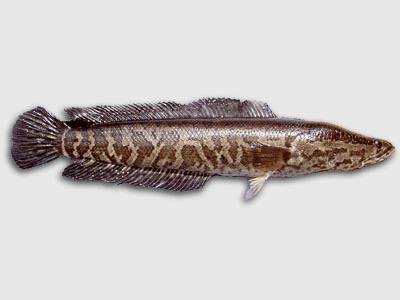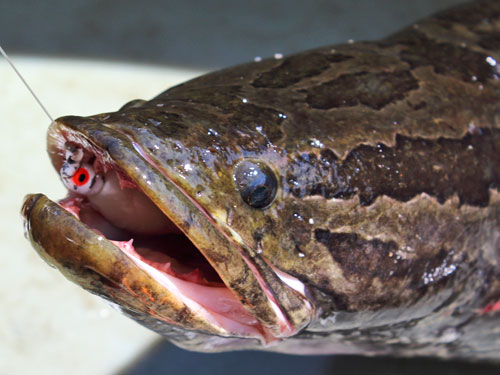
One of the most recognized aquatic invasive species in the Mid Atlantic is the northern snakehead.
Snakeheads where first discovered in a Crofton, Maryland pond in the summer of 2002. In response, officials immediately implemented an eradication plan.
While draining the pond, two adult snakeheads and over 100 juvenile fish were caught and destroyed.
As part of the eradication attempt, rotenone was added to three nearby ponds in order to kill any additional snakeheads in the impoundments.
According to reports, the outbreak was traced back to the intentional release of two adult fish into the pond.
In 2004, several northern snakeheads were captured in the Potomac River, and it was confirmed that the species had become established.
According to biologists, the range of northern Snakeheads in the Potomac watershed extends upstream to the Great Falls, and downstream to the Chesapeake Bay, including Mattawoman Creek and other tributaries.
Over time, northern snakeheads have expanded their range throughout the Chesapeake Bay watershed.
Northern snakeheads are known to exist in the Susquehanna River, in Conowingo Pool and below Conowingo Dam. They are sometimes caught along the Susquehanna Flats.
Snakehead populations are established in the Gunpowder, Patapsco, Rhode, Severn, Patuxent, and other rivers along the western shore of Maryland.
In 2022, northern snakeheads were discovered in the interior waterways of Poplar Island.
In Tidewater Virginia, northern snakeheads are found in the Rappahannock, York, and James watersheds.
On the Eastern Shore of Maryland, northern snakeheads are established in the Chester, Elk, Wye, Choptank, Blackwater, Transquaking, Chicamacomico, Nanticoke, Wicomico, and Pocomoke watersheds. Northern snakeheads are also found in creeks and farm ponds of Virginia’s Eastern Shore.
In Pennsylvania and New Jersey, northern snakeheads are established along the Delaware River. Around the city of Philadelphia, a snakehead fishery attracts a dedicated group of urban anglers.
Snakehead catches have been reported in several tributaries below Philadelphia. Catches of northern snakeheads are occasionally reported in the upper Delaware.
In New York, scattered catches of northern snakeheads have been reported from waterways on Long Island.
How To Catch Snakeheads

Northern snakeheads are caught using live baits, cut baits, or artificial lures. Most of the fishing is done with artificial lures, although baits are preferred in some areas.
Northern snakeheads prefer shallow, slow moving water with plenty of cover such as spatterdock, submerged aquatic grasses or other aquatic vegetation.
They may also be found around downed timber or other submerged hazards. Their preference for heavy cover can creates challenges for anglers.
Fishing for snakeheads begins in the spring, when they become active prior to spawning. During some phases of the spawning season, snakeheads may refuse to bite.
After spawning, snakeheads remain active all season until the return of cold weather.
Anglers that target snakeheads often use many of the same lures and techniques that are popular in largemouth bass fishing.
Effective lures include artificial frogs, chatterbaits, buzzbaits, spinners, topwater plugs, soft plastics, and others.
Anglers often report that snakeheads respond well to bright, flashy lures that cause a lot of surface commotion.
Another technique for catching snakeheads is fishing with jigs fitted with soft plastic bodies. Favorite lures include twister or paddle tail bodies in white, pearl, and other bright colors.
When fishing for large snakeheads, size often matters, with some anglers opting for lure bodies that are 5 inches or more in length. Plastic bodies are rigged on jig heads or offset worm hooks that are large enough to hold trophy-class fish.
Soft plastic jigs are usually casted near heavy cover and retrieved into open water. Snakeheads may take the lure immediately, or follow it into deeper water before attacking.
For some anglers, live baits are a good choice for catching snakeheads. Popular live baits include large minnows, small sunfish, or other available baits. Baits are usually fished on wire or heavy mono under a large float.
Live bait fishing is popular along bridges, bulkheads, piers and other areas with shoreline access. Shore fishermen often require heavier tackle in order to control fish that would otherwise move off into heavy cover and damage the line.
In some areas, snakeheads are harvested by bowfishing or other alternative fishing methods.
Handling snakeheads can present a number of challenges. They have sharp teeth, strong jaws, and can inflict painful bites. Their strong bodies are covered with slime, making them extremely difficult to handle. To subdue these impressive fighters, anglers generally use landing nets and specialized tools that grip fish by the jaws.
Snakeheads are edible and make good table fare. They yield thick fillets of white, mild tasting flesh. Most anglers remove the skin, either before or after filleting.
Maryland, Virginia, and the Potomac River Fisheries Commission have regulations in effect regarding the possession or release of live northern snakeheads. Additionally, Federal law prohibits the transport of live snakeheads into the U.S. or across State lines.
Similar Species
Two species of freshwater fish are sometimes mistaken for snakeheads; the bowfin and the burbot. Bowfin are distinguished from the northern snakehead by their short anal fin, pelvic fins in an abdominal position, and rounded tail fin. Juvenile and male bowfin have an eyespot on the tails.
Burbot can be distinguished from the northern snakehead by several characteristics; although both species have long dorsal fins, the burbot’s dorsal is split, with a short dorsal fin in front of a longer one. Burbot also possess a single barbel (whisker) beneath the lower jaw.